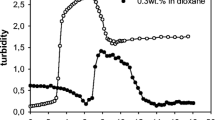Abstract
Radical heterophase polymerization of styrene in glacial acetic acid initiated with either 2,2′-azobisisobutyronitrile or poly(ethylene glycol)-azo initiators and in the presence of poly(methyl methacrylate) or poly(ethylene glycol) macromonomers is described for the first time ever. It turned out to be a convenient route to amphiphilically stabilized block copolymer dispersions. These block copolymers, after the polymerization in glacial acetic acid, can be easily transferred to other continuous phases which are selective solvents for one of the different constituent blocks. Electron microscopy results are presented regarding the morphology of the block copolymer particles in glacial acetic acid, water, and in a mixture of tetralin, cis-decalin, and tetrachlormethane. Depending on the particular composition of the block copolymers and the nature of the continuous phase, the changes in the morphology for a given block copolymer can be quite dramatic.

























Similar content being viewed by others
References
Tauer K, Khrenov V (2002) Polymer dispersions as intermediate state during the synthesis of specialty polymers. Macromol Symp 179:27–52
Tauer K, Khrenov V, Shirshova N, Nassif N (2005) Preparation and application of double hydrophilic block copolymer particles. Macromol Symp 226:187–201
Tauer K, Mukhamedjanova M, Holtze C, Nazaran P, Lee J (2007) Unusual kinetics in aqueous heterophase polymerizations. Macromol Symp 248:227–238
Tauer K, Weber N, Nozari S, Padtberg K, Sigel R, Stark A, Voelkel A (2009) Heterophase polymerization as synthetic tool in polymer chemistry for making nanocomposites. Macromol Symp 281:1–13
Tauer K, Weber N, Texter J (2009) Core–shell particle interconversion with di-stimuli-responsive diblock copolymers. Chem Commun 40:6065–6067
Topp MDC, Leunen IH, Dijkstra PJ, Tauer K, Schellenberg C, Feijen J (2000) Quasi-living polymerization of N-isopropylacrylamide onto poly(ethylene glycol). Macromolecules 33:4986–4988
Zintchenko A, Dautzenberg H, Tauer K, Khrenov V (2002) Polyelectrolyte complex formation with double hydrophilic block polyelectrolytes: effects of the amount and length of the neutral block. Langmuir 18(4):1386–1393
Fleischmann S, Percec V (2010) SET-LRP of MMA in acetic acid. J Polym Sci Pol Chem 48:4889–4893
Karpetyan SA, Smirnov BR (1987) On solvents effects in radical polymerization. Vysokomol Soedin 29:2102–2109
Kizhnyaev VN, Tsypina NA, Smirnov AI (2003) Medium effect on free-radical polymerization of N-vinyltriazoles. Vysokomol Soedin 45:1253–1258
Koroljov GV, Perepelizina EO (1997) Influence of intermolecular interactions on the kinetics of radical polymerization of nonyl acrylate. Vysokomol Soedin 39:338–341
Mitra BC, Chadha SC, Ghosh P, Palit SR (1966) Studies on some radical transfer reactions. Part I. Hydrogen atom abstraction from some organic substrates by OH radicals. J Polym Sci A1 4:901–906
de Hoog EHA, Kegel WK, van Blaaderen A, Lekkerkerker HNW (2001) Direct observation of crystallization and aggregation in a phase-separating colloid-polymer suspension. Phys Rev E 64:021407-1–021407-9
Tauer K, Antonietti M, Rosengarten L, Muller H (1998) Initiators based on poly(ethylene glycol) for starting heterophase polymerizations: generation of block copolymers and new particle morphologies. Macromol Chem Phys 199:897–908
Walz R, Bömer B, Heitz W (1977) Monomeric and polymeric azoinitiators. Makromol Chem 178:2527–2534
Tauer K, Müller H, Rosengarten L, Riedelsberger K (1999) The use of polymers in heterophase polymerizations. Colloid Surf A 153:75–88
Weber N, Tiersch B, Unterlass MM, Heilig A, Tauer K (2011) "Schizomorphic" emulsion copolymerization particles. Macromol Rapid Comm 32:1925–1929
Filimon M, Kopf I, Schmidt DA, Brundermann E, Ruhe J, Santer S, Havenith M (2011) Local chemical composition of nanophase-separated polymer brushes. Phys Chem Chem Phys 13:11620–11626
Zuyderhoff EM, Dupont-Gillain CC (2012) Nano-organized collagen layers obtained by adsorption on phase-separated polymer thin films. Langmuir 28:2007–2014
Leung BO, Hitchcock AP, Brash JL, Scholl A, Doran A (2010) An X-ray spectromicroscopy study of protein adsorption to polystyrene-poly(ethylene oxide) blends. Langmuir 26:14759–14765
Mu D, Huang XR, Lu ZY, Sun CC (2008) Computer simulation study on the compatibility of poly(ethylene oxide)/poly(methyl methacrylate) blends. Chem Phys 348:122–129
Eser H, Tihminlioglu F (2005) Solubility and diffusivity of solvents and nonsolvents in poly(methyl methacrylate co butyl methacrylate). Fluid Phase Equilibr 237:68–76
Bailey FE, Koleske JV (1976) Poly(ethylene oxide). Academic, London
Tauer K (1995) Block copolymers prepared by emulsion polymerization with poly(ethylene oxide)-azo-initiators. Polym Adv Technol 6:435–440
Miller-Chou BA, Koenig JL (2003) A review of polymer dissolution. Prog Polym Sci 28:1223–1270
Braun D, Arcache G (1971) Influence of aromatic azo compounds on free radical polymerization of styrene. Makromolekul Chem 148:119–129
Tauer K, Yildiz U (2003) Reactive poly(ethylene glycol)s in aqueous radical heterophase polymerization. Macromolecules 36:8638–8647
Ritchie RO, Buehler MJ, Hansma P (2009) Plasticity and toughness in bone. Phys Today 62:41–47
Fratzl P, Barth FG (2009) Biomaterial systems for mechanosensing and actuation. Nature 462:442–448
Hofstetter K, Gamstedt EK (2009) Hierarchical modelling of microstructural effects on mechanical properties of wood. Holzforschung 63:130–138
Acknowledgments
The authors gratefully acknowledge preparative and analytical assistance by Mrs. U. Lubahn and Mrs. S. Pirok. For taking the huge amount of SEM and TEM images, the authors thank Mrs. R. Pitsche and Mrs. H. Runge. Financial support by the Max Planck Institute of Colloids and Interfaces is gratefully acknowledged.
Author information
Authors and Affiliations
Corresponding author
Rights and permissions
About this article
Cite this article
Roohi, F., Tauer, K. Amphiphilically stabilized block copolymer particles via heterophase polymerization in glacial acetic acid. Colloid Polym Sci 291, 3–20 (2013). https://doi.org/10.1007/s00396-012-2737-4
Received:
Revised:
Accepted:
Published:
Issue Date:
DOI: https://doi.org/10.1007/s00396-012-2737-4




